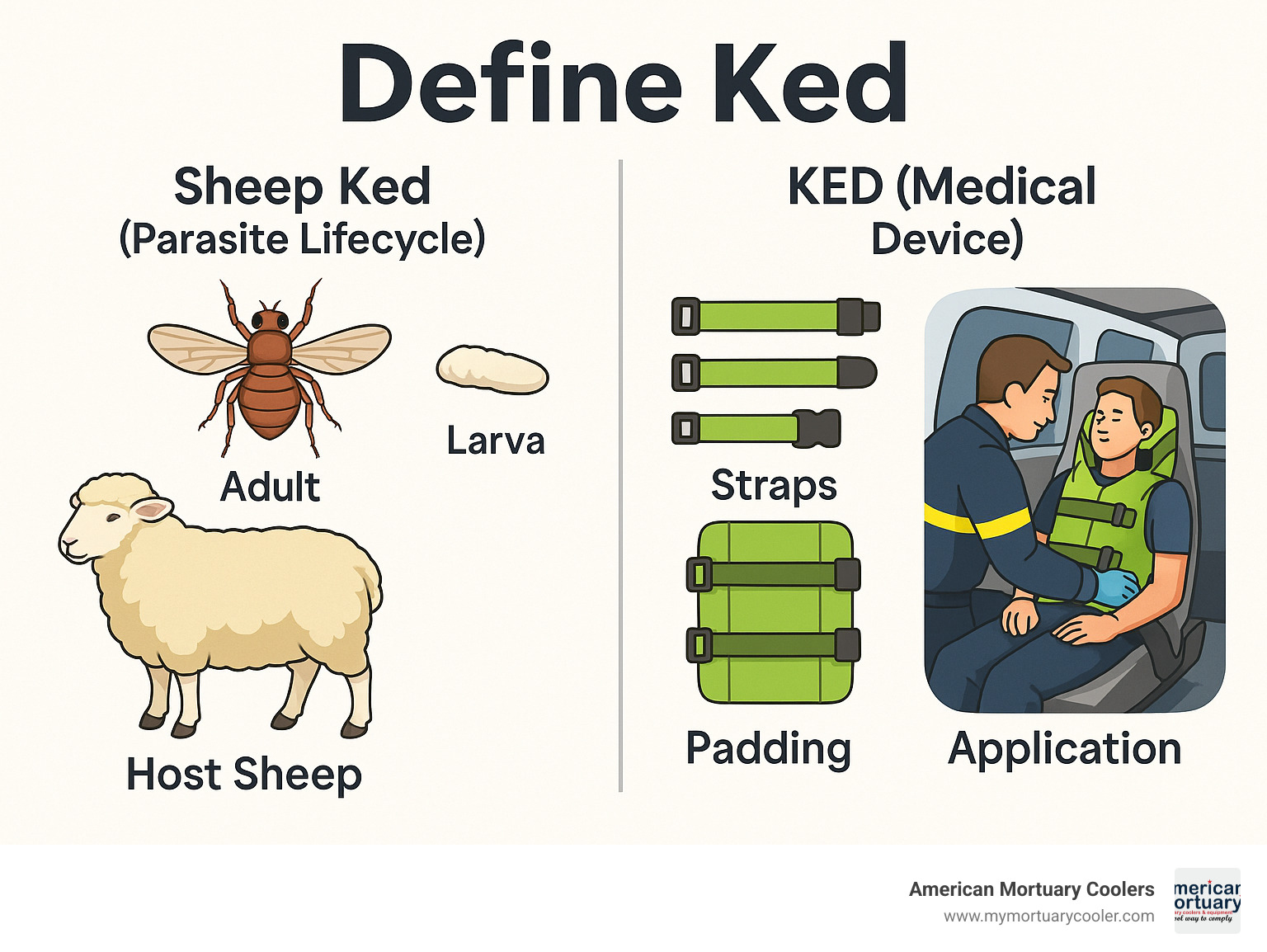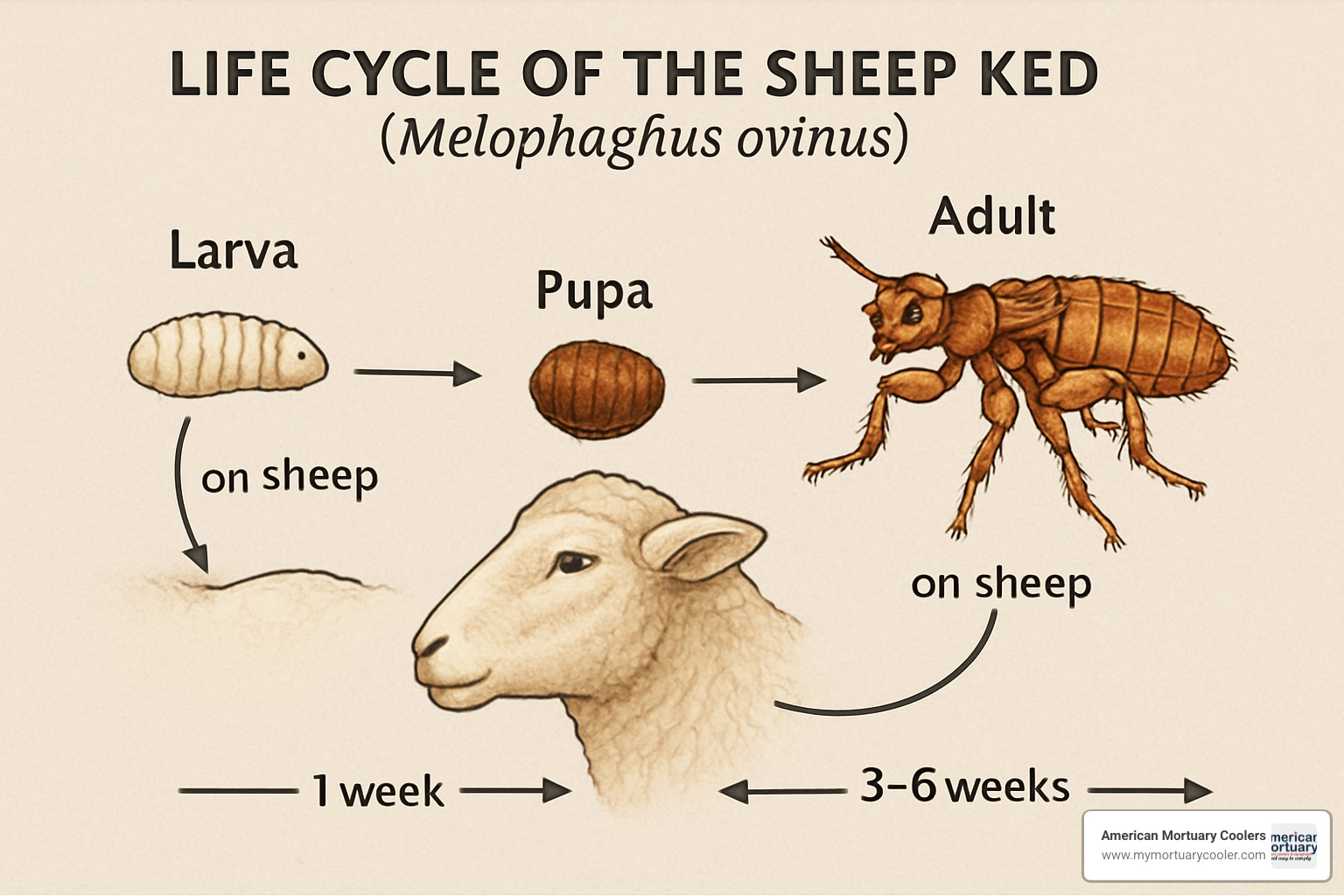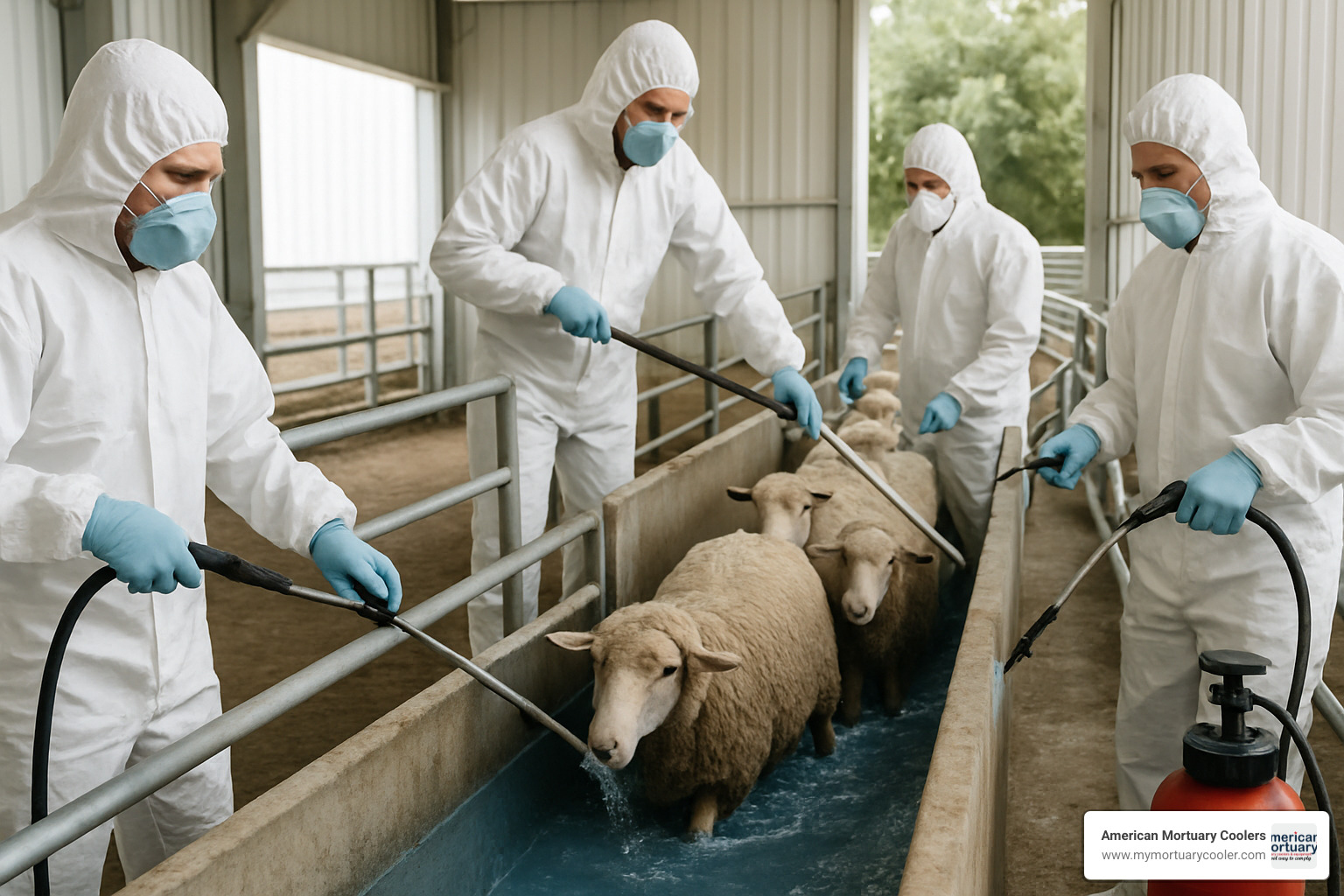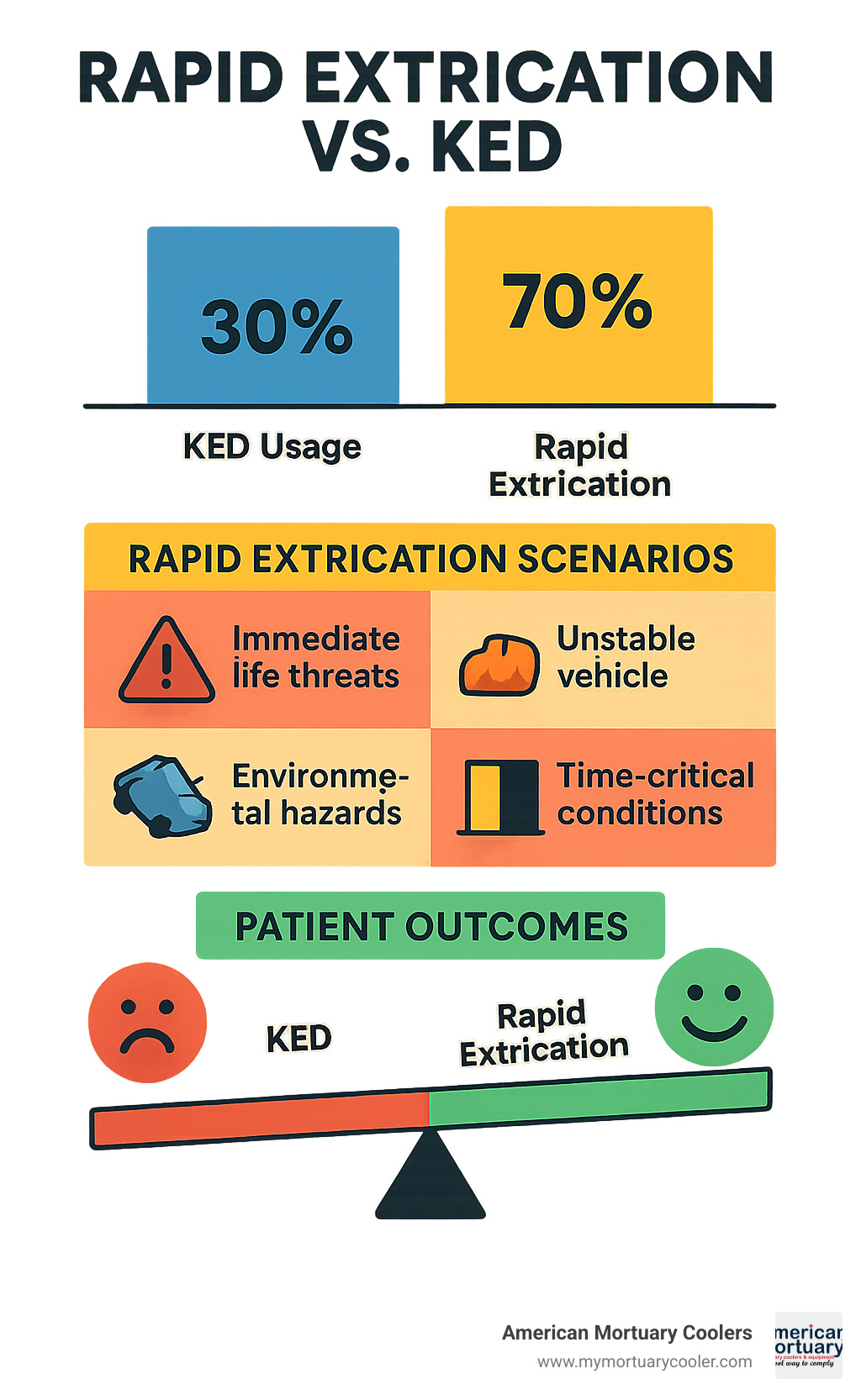Understanding Ked: Two Distinct Definitions You Need to Know
When people define ked, they're usually referring to one of two completely different things: a blood-sucking parasitic fly that attacks sheep, or a medical device used to stabilize trauma patients during vehicle rescues.
Quick Definition:
- Ked (insect): A wingless, blood-feeding fly (Melophagus ovinus) from the Hippoboscidae family that parasitizes sheep and other livestock
- KED (device): Kendrick Extrication Device - a semi-rigid immobilization tool used by emergency responders to stabilize patients during vehicle extraction
The biological ked is a 4-6 mm reddish-brown parasite that feeds exclusively on sheep blood, causing wool damage and potentially transmitting diseases like sheep trypanosomiasis. These wingless flies spend their entire life cycle on their host, making them particularly troublesome for livestock operations.
The medical KED, invented in 1978, consists of wooden or polymer bars within a nylon jacket with multiple straps designed to immobilize a patient's spine during rescue operations. Emergency medical technicians use specific techniques and mnemonic devices to properly apply this life-saving equipment.
Both definitions trace back to the 16th century word "cade," though they've evolved into completely separate fields - veterinary parasitology and emergency medicine.
I'm Mortuary Cooler, a national-level mortuary cooler supplier with extensive experience helping funeral professionals understand specialized equipment terminology, including when they need to define ked devices in emergency medical contexts. My background in mortuary equipment has given me unique insight into the crossover between medical terminology and funeral service applications.

Define ked terms to learn:
Define Ked: Origins, Meanings, and Pronunciation
When you define ked, you're stepping into a word with fascinating dual meanings that couldn't be more different. The primary definition refers to a nasty little parasite that makes sheep miserable, while the secondary meaning involves life-saving medical equipment.
A ked is a wingless, blood-sucking fly from the Hippoboscidae family, specifically Melophagus ovinus. These dark red parasites are about 4-6 mm long and spend their entire lives clinging to sheep, earning them colorful nicknames like sheep tick and louse fly.
The pronunciation is simple: /kɛd/ - it rhymes with "red" or "bed." When you have more than one, they're called keds. The term first appeared in English between 1560-70, though the specific phrase "sheep ked" didn't show up until 1925.
These persistent parasites are obligate parasites, meaning they literally cannot survive without their sheep hosts. You'll typically spot them on a sheep's neck and forelimbs, where they feed on blood and potentially spread sheep trypanosomiasis.
In the medical world, KED stands for Kendrick Extrication Device - a completely different beast that helps emergency responders stabilize trauma patients during vehicle rescues.
| Feature | Insect Ked | KED Device |
|---|---|---|
| Definition | Parasitic fly | Medical immobilization device |
| Size | 4-6 mm | Full torso coverage |
| Purpose | Blood feeding | Spinal stabilization |
| Host/User | Sheep, livestock | Emergency medical personnel |
| Material | Chitin exoskeleton | Nylon jacket with rigid bars |
| Mobility | Wingless but mobile | Stationary when applied |
For deeper scientific details, the Encyclopedia article about sheep ked provides comprehensive information about these persistent parasites.
Historical Roots & Time-Traveler Facts
The story behind "ked" takes us back to the 1500s, when farmers first started calling these pesky parasites "cade." The word's journey through time connects to Proto-Germanic roots, showing how our ancestors dealt with the same livestock problems we face today.
Collins Dictionary records show this term has been frustrating farmers for over 400 years. Early veterinary texts from the 1800s reveal some creative solutions - one 1839 document noted that "pouring with tobacco liquor is fatal to these insects."
The transition from "cade" to "ked" happened gradually, with the modern spelling becoming standard as English evolved. The specific term "sheep ked" emerged in 1925 when livestock science demanded more precise terminology.
Alternative Forms & Global Terms
The word "ked" has traveled the world alongside sheep farming, picking up interesting variations along the way. The original 16th-century form "kade" still appears in some historical texts.
Different countries have developed their own names for these universal sheep pests. In Czech, they're called kloš, while Finnish farmers know them as täikärpänen. Hungarian sheep herders deal with kullancslegy, and Swedish farmers battle fårlus. German speakers call them Schaflausfliege.
What's fascinating is how most of these international terms translate to some version of "sheep louse fly" - proving that farmers everywhere recognize the same annoying relationship between these parasites and their woolly hosts.
Life Cycle, Host Range, and Impact on Livestock
When you define ked from a biological perspective, you're looking at one of nature's most persistent parasites. The sheep ked has a fascinating and somewhat unusual life cycle that makes it particularly challenging to control.
Unlike most insects that lay eggs, sheep keds are viviparous - they give birth to live young. The female ked produces just one larva at a time, which she deposits directly onto the sheep's fleece. This larva immediately enters the pupal stage, essentially creating a protective cocoon right there in the wool.
After 19-24 days, a fully formed adult emerges and immediately begins its blood-sucking lifestyle. These adults are quite distinctive - they measure 4-6 mm in length and have a dark red to brown coloration. You'll typically find them clustered on the neck and forelimbs where the wool is thinner and feeding is easier.

What makes keds particularly troublesome is their strong claws that grip wool fibers like tiny struggling hooks. These wingless flies aren't going anywhere once they've found their host - they're built for staying power, not mobility.
While sheep are their preferred hosts, keds aren't completely picky. Goats serve as occasional hosts, and wild deer populations can harbor them as well. Cattle rarely host keds, and when they do, it's usually from accidental transfer during mixed grazing situations.
The economic impact hits livestock operations hard. Infested sheep become irritated and restless, constantly scratching against fences, posts, and feeding equipment. This behavior damages the wool and reduces fleece quality.
Heavy infestations create even bigger problems. Young or weak animals can develop anemia from the constant blood loss. The stress reduces feed efficiency and slows weight gain, meaning it takes longer and costs more to bring animals to market weight.
Research shows that even moderate ked populations can reduce wool production by 5-10% and downgrade hide quality. For commercial operations, this directly impacts the bottom line.
Define Ked in Veterinary Context
When veterinarians define ked in clinical practice, they're describing both a parasite and a significant disease vector. Sheep keds serve as the primary carrier for sheep trypanosomiasis, a blood-borne disease that causes chronic weight loss and reduced productivity in infected flocks.
Proper diagnosis requires distinguishing keds from other common sheep parasites. Lice are much smaller and have completely different life cycles requiring different treatment approaches. Scab mites create distinctive skin lesions and actually burrow into the skin rather than staying on the surface.
Ked infestations typically peak during shearing season when sheep handling increases and parasites can easily transfer between animals. Smart veterinarians time their inspections around these periods, focusing on the neck and shoulder areas where keds congregate.
The diagnostic process is refreshingly straightforward - visual inspection usually reveals the problem quickly. Treatment success depends entirely on understanding ked biology. Since these parasites spend their complete life cycle on the host, properly timed treatments can eliminate entire populations in one go.
Keds, Disease Transmission, and Control Strategies
When sheep keds bite and feed, they're doing more than just causing irritation. These tiny parasites act as disease vectors, carrying serious health threats from one animal to another. The most concerning disease they transmit is sheep trypanosomiasis, a blood-borne infection that can devastate flock health and farm profits.
The disease transmission process is straightforward but dangerous. When a ked feeds on an infected sheep, it picks up the disease-causing organisms in its blood meal. These pathogens survive in the ked's digestive system for weeks, turning each parasite into a walking disease factory.
Beyond trypanosomiasis, keds cause dermatitis at feeding sites. The constant scratching and irritation often leads to secondary bacterial infections, creating open wounds that attract flies and other pests.

The economic damage is sobering. Research shows that untreated ked infestations can slash wool production by 5-15% and reduce weight gain in young animals by up to 20%. Reproductive success drops by 8-12%, and hide quality suffers enough to downgrade market value significantly.
Fortunately, modern ked control strategies are highly effective when applied correctly. Insecticidal dips remain the gold standard for large flocks, using organophosphates or pyrethroids in specially designed facilities. Pour-on treatments offer convenience for smaller operations, allowing farmers to apply systemic insecticides directly to each animal's back.
Ivermectin injections provide broad-spectrum protection against keds and other parasites simultaneously. Many farmers appreciate this approach because it addresses multiple parasite problems with a single treatment. The key is timing these treatments to coincide with shearing schedules, when sheep are already being handled and keds are most vulnerable.
Proper shearing hygiene plays a crucial role in prevention. Cleaning equipment between animals prevents accidentally spreading keds throughout the flock. Similarly, quarantining new animals before introducing them to the main flock can prevent bringing in ked-infested sheep.
Interestingly, historical remedies weren't entirely wrong. An 1839 veterinary text noted that "pouring with tobacco liquor is fatal to these insects," referring to tobacco-based treatments that actually worked. While we don't recommend tobacco treatments today, it shows that farmers have been battling keds for centuries.
Success requires treating entire flocks simultaneously to prevent reinfection. It's also smart to rotate between different chemical classes to prevent resistance development. Regular monitoring through visual inspections helps ensure treatments are working.
For those interested in medical equipment terminology, our comprehensive guide on All About KED: Meaning, Definition, and Usage explains how the acronym KED applies in emergency medical contexts.
Kendrick Extrication Device (KED): Definition, Uses, and Controversies
When emergency responders need to define ked in medical terms, they're talking about something completely different from sheep parasites. The Kendrick Extrication Device, or KED, is a life-saving piece of equipment that's been helping rescue teams safely remove trauma patients from vehicles since 1978.
The story behind the KED is pretty interesting. It was originally invented for race car driver rescue - those high-speed crashes where every second counts and spinal injuries are a major concern. The device earned patent number 4,211,218 in 1980, and it quickly became standard equipment for emergency medical services across the country.

The KED looks like a padded vest with wooden or polymer bars sewn into a nylon jacket. It has three torso straps that wrap around the chest and abdomen, two leg straps for the lower body, and two head straps for cervical spine protection. The whole system works together to keep a patient's spine perfectly aligned during the tricky process of getting them out of a crashed vehicle.
Here's where things get interesting - and a bit controversial. Emergency medical professionals have debated the proper strap order for years. Most teams now follow the mnemonic "My Baby Looks Hot Tonight" to remember the sequence: Middle torso strap first, then Bottom torso, Leg straps, Head straps, and finally the Top torso strap just before moving the patient.
But not everyone agrees the KED should always be used. A 2015 evidence review shook up the emergency medical community by questioning whether the device actually improves patient outcomes. Some critics argue that rapid extrication - getting patients out quickly without the KED - might be better in certain situations.
The debate centers on time versus thoroughness. In cases where the scene is unsafe, the patient is losing blood pressure rapidly, or there are other victims who need help, those extra minutes spent applying a KED could make the difference between life and death.
For emergency responders trying to make these split-second decisions, our Understanding KED EMS: A Comprehensive Guide breaks down the decision-making process in detail.
Define Ked in Emergency Medicine
In emergency medicine, when you define ked, you're describing a specialized tool that bridges the gap between first contact with a trauma patient and full spinal immobilization. Think of it as a halfway step - more protection than just holding someone's head still, but not as comprehensive as a full backboard.
The device requires proper training to use effectively. EMT-Basic certification is the minimum requirement, but that's just the starting point. Responders need hands-on practice with the mnemonic "My Baby Looks Hot Tonight" until they can apply the straps in the correct order without thinking about it.
Pediatric padding presents special challenges. Children have proportionally larger heads than adults, which can cause dangerous neck flexion if the KED isn't properly adjusted. Extra padding behind the shoulders helps maintain proper spinal alignment, but it requires additional training and equipment.
The KED differs significantly from semi-rigid boards and long spine boards in important ways. While a long backboard provides full-body immobilization, it's nearly impossible to slide one behind a seated patient in a car. The KED's design allows it to be inserted into tight spaces and wrapped around the patient while they're still in their original position.
Sheep Ked vs KED Device—Key Differences
The contrast between these two meanings of "ked" shows just how diverse medical and agricultural terminology can be. When someone asks you to define ked, you really need to know what field they're talking about.
The biological differences are obvious - one is a living parasite, the other is manufactured equipment. But the functional differences tell a more interesting story. Sheep keds are disease vectors that harm their hosts, while KED devices are spinal protectors designed to prevent harm.
The materials couldn't be more different either. Sheep keds have chitin exoskeletons that evolved over millions of years for gripping wool and penetrating skin. KED devices use nylon and wood or polymer materials engineered for strength, comfort, and easy cleaning.
From a cost perspective, both types of "ked" represent significant economic considerations. Sheep keds reduce livestock productivity and require ongoing pest control investments. Medical KEDs prevent spinal injuries that could result in lifetime disability costs, making them valuable despite their upfront expense.
The user groups rarely overlap. Veterinarians and farmers deal with parasitic keds, while EMTs and paramedics work with medical KEDs. However, rural emergency responders might encounter both in the same day - treating a farmer injured in a livestock accident.
Other Meanings, Abbreviations, and Related Terms
When you define ked in today's world, you'll find these three letters show up in surprising places beyond sheep parasites and medical devices. The acronym KED has found its way into everything from cutting-edge physics to everyday car keys.
In the technical world, Knife-Edge Diffraction describes how electromagnetic waves bend around sharp edges - a phenomenon that's crucial for understanding radio and cellular communications. Physics researchers also use KED to mean Kinetic Energy Distribution, which explains how energy spreads among particles in motion.
Your car might use a Keyless Entry Device (another KED), while medical labs rely on K-Edge Densitometers for precise measurements. These diverse applications show how versatile three simple letters can be across different industries.
The business world has adopted KED too. Kayne Anderson Energy manages investment portfolios, while Korea Enterprise Data Co., Ltd handles technology solutions. Even Korea Economic Daily uses these initials for their newspaper brand.
In Germany, you'll find Kirchlicher Entwicklungsdienst (churches' development service) and Katholische Elternschaft Deutschlands (Catholic parents' organization). American schools use KED for Kindergarten Extended Day programs, proving these letters work in education too.

The maritime connection runs deep with the kedge anchor - a small anchor sailors use for maneuvering ships in tight spaces. This nautical term shares the same Middle English root "caggen" (meaning "to tie") with our parasitic ked, showing how language connects seemingly unrelated concepts across centuries.
Internationally, similar-sounding words carry different meanings. In Yoruba, "kéde" means to announce something important. Danish speakers use "kede" when they're feeling bored, while Hungarian "ked" relates to someone's mood or disposition.
Plurals, Synonyms, and Colloquialisms
The word "keds" follows standard English rules for plurals, but it's gathered quite a collection of alternative names over the years. Most farmers and veterinarians call them sheep ticks, even though they're actually flies, not ticks at all.
Louse fly is the technically correct common name, while hippoboscid fly gets used in scientific papers. The formal scientific name Melophagus ovinus appears in research journals, but you won't hear farmers using that tongue-twister in everyday conversation.
Colloquial terms vary by region. Some folks say sheep louse or wool tick, while others refer to ked itch when describing the skin irritation these parasites cause. The original 16th-century term "cade" still appears in historical agricultural texts, along with its variant "kade."
Frequently Asked Questions about Ked
What does "define ked" cover—bug, device, or both?
This is probably the most common question we get, and honestly, it's perfectly understandable why people are confused. When someone asks you to define ked, you're actually dealing with two completely different worlds that just happen to share the same three letters.
If you're talking to a farmer, veterinarian, or anyone in livestock management, they're thinking about that pesky little parasite - the sheep ked. It's a 4-6 mm wingless fly that makes sheep miserable and costs farmers real money through reduced wool quality and stressed animals.
But if you're in an emergency room, ambulance, or anywhere around medical professionals, KED means something entirely different. They're talking about the Kendrick Extrication Device - that semi-rigid vest-like contraption that helps stabilize someone's spine during a car accident rescue.
The context usually makes it pretty clear which one someone means. A sheep farmer probably isn't asking about medical devices, and an EMT isn't typically worried about livestock parasites. But when you're reading about either topic, it's worth knowing that both definitions are completely legitimate and widely used in their respective fields.
Are sheep keds harmful to people or just animals?
Here's some good news - sheep keds are pretty much a sheep-only problem. These little parasites have spent thousands of years evolving specifically to live on sheep, and human skin just doesn't work for them. They can't set up shop on people and start a family.
That said, they're not completely harmless to humans. If you're handling infested sheep, keds might crawl onto you temporarily, and some people develop skin irritation from the brief contact. It's usually just itchy and annoying rather than dangerous.
The bigger concern for people is actually economic. When keds infest a flock, they can reduce wool production by 5-15% and cause weight loss in the animals. For farmers, that translates directly into lost income and increased veterinary costs.
There's also a small possibility of disease transmission. Keds carry sheep trypanosomiasis, and while it's extremely rare for this to affect humans, it's not impossible. Most veterinarians recommend wearing gloves when handling heavily infested animals, just to be safe.
The bottom line? Keds are primarily a livestock problem, not a human health crisis. But if you work with sheep regularly, basic precautions like gloves and good hygiene make sense.
When should rescuers choose rapid extrication over a KED?
This question gets to the heart of one of the biggest debates in emergency medicine right now. The traditional approach has been to use a KED whenever possible, but modern research suggests that rapid extrication might actually be better in many situations.
Life-threatening emergencies always trump spinal precautions. If someone is bleeding out, can't breathe, or is in cardiac arrest, you don't have time to carefully apply seven different straps. Get them out fast and deal with the spine later.
Environmental dangers are another clear signal for rapid extrication. If the car is on fire, positioned dangerously on a cliff, or there are hazardous chemicals involved, speed becomes the priority. A perfectly immobilized spine won't help if the patient dies from smoke inhalation.
Sometimes it's about access to other victims. If the person you're treating is blocking your path to someone who's more critically injured, you might need to move the first patient quickly to save the second one.
The controversial part comes with less obvious situations. A 2015 research review found that KEDs might not actually improve patient outcomes as much as we thought. Some emergency services are moving toward faster, simpler extraction methods even when there's no immediate life threat.

The key is clinical judgment. Every situation is different, and experienced EMTs learn to weigh the risks of spinal injury against the risks of delayed treatment. It's not an easy call, which is why this remains one of the most debated topics in emergency medicine training.
Conclusion
When you need to define ked, you're stepping into two completely different worlds that couldn't be more opposite. On one side, there's the tiny sheep parasite causing headaches for farmers across the globe. On the other, there's a life-saving medical device that emergency responders rely on to protect accident victims from spinal injuries.
The sheep ked might be small at just 4-6 mm, but its impact on livestock operations is anything but tiny. These wingless blood-suckers can slash wool production by up to 15% and turn profitable sheep operations into struggling businesses. Understanding their viviparous life cycle and implementing smart control strategies—from modern pour-on treatments to proper shearing hygiene—can mean the difference between thriving flocks and costly losses.
The Kendrick Extrication Device tells a different story entirely. Since its invention in 1978, this semi-rigid immobilization tool has sparked debates among emergency medical professionals. While some question its universal effectiveness, properly applied KEDs using the "My Baby Looks Hot Tonight" sequence continue protecting spinal injury victims during vehicle extractions. The key lies in knowing when to use it and when rapid extrication takes priority.
Here at American Mortuary Coolers, we've learned that professional terminology often crosses unexpected boundaries. Our work serving funeral professionals throughout Tennessee, Georgia, Illinois, South Carolina, Texas, California, New York, Pennsylvania, and across the Midwest, Northeast, Rocky Mountain, Southeast, Southwest, and Pacific regions has shown us how medical equipment knowledge matters in multiple industries.
Just as we craft durable, custom mortuary coolers with direct delivery across the contiguous 48 states, mastering these specialized terms requires attention to detail and commitment to excellence. Whether you're protecting sheep from parasitic flies or stabilizing trauma patients, the right knowledge and equipment make all the difference.
The beauty of language lies in how three simple letters—K-E-D—can represent such diverse yet important concepts. From the ancient Proto-Germanic roots of "cade" to modern emergency medicine protocols, these terms continue evolving while serving essential roles in their respective fields.
For deeper insights into emergency medical equipment and its applications in funeral services, our Comprehensive Guide to KED, EMT Mattress Cots & Stretchers explores how these tools intersect with funeral industry needs.
The next time someone asks you to define ked, you'll have the confidence to provide accurate information for both contexts. Whether they're dealing with sheep parasites or emergency medical situations, you'll be ready to help them understand exactly what they need to know.


















